 |
 |
|
 |
Paving smarter: Field trials test intelligent compaction methods |
 |
 |
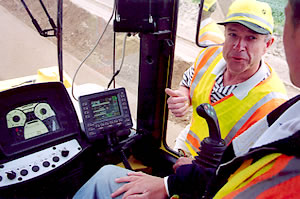 |
|
Frank Heng, District 8 soils engineer, checks in with a roller operator on the Hwy 12 reconstruction project near Willmar. Photo by Craig Wilkins |
“Intelligent compaction” might sound like a newly automated method to crush soda and beer cans for recycling. It isn’t.
But more people are learning what it does mean—using precise, computer-aided methods to ensure that the compaction of grading soils and aggregate base materials meet Mn/DOT’s quality and design standards.
Field trials using IC technology are now underway in the Willmar, Mankato and Duluth districts. Additional trials are planned as the Hwy 212 construction project gets underway.
The process marks a departure from Mn/DOT’s standard quality assurance and quality control measures that are cumbersome, time-consuming and may not represent the as-constructed project accurately, said John Siekmeier, a senior research engineer and IC project manager with the Office of Materials.
Standard measures provide data from only one point in a project; pavement as little as 10 feet away may have different ratings for density and other compaction factors.
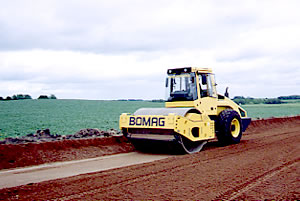 |
The IC-equipped roller collects data continuously as it compacts gravel on the Hwy 12 project. Photo by Craig Wilkins |
IC technology, however, provides a constant stream of data about pavement conditions as the compaction roller equipped with on-board sensors and a computer moves across the project area.
Instead of relying solely on manual testing methods such as sand cones or the lightweight deflectometer, IC methods are being tested to determine how quickly and accurately they measure the compacted materials’ stiffness which is affected by factors such as density, moisture content and shear strength, Siekmeier said.
On Hwy 12 in Atwater, just east of Willmar, District 8 is using IC technology where it’s rebuilding an 11-mile section of the roadway.
Art Bolland, district materials engineer, said the IC process provides a “map” of pavement conditions that inform project managers about areas that may need additional compaction or adjustment of roller pressure settings as conditions change.
On the Hwy 12 project, for example, roller settings were changed to allow for clay subsoils weakened by several weeks of rain based on data from the IC-equipped roller.
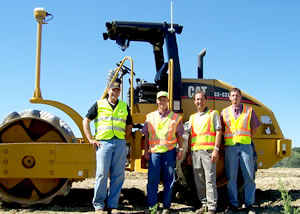 |
Meeting near Waseca where the IC process is being used for the Hwy 14 reconstruction project are (from left) Tom Congdon, Caterpillar Corp.; Chad Fowlds, resident engineer at Mankato; Brian Mathiowetz, Mathiowetz Construction Co., Sleepy Eye, and Dr. David White, an Iowa State University researcher. Photo by Charlie Kremer |
Bolland said the data collected can also be used to set standards for future projects.
Experience shows that data can be collected so quickly that, for example, roller operators can adjust their equipment settings on the fly to ensure maximum strength and uniformity, Siekmeier said.
“This kind of smart technology gives smart people another tool to use for making better decisions,” he said.
The ability to make changes while the project is in progress and ensure quality standards can create great value for a project, Siekmeier said.
“We’re looking at projects statewide to see how we can cut life-cycle costs while improving reliability and performance by consistently meeting design specifications,” he said.
By Craig Wilkins
|
back

|
 |
Four Mn/DOT employees named to state ‘Excellence’ steering teams |
 |
 |
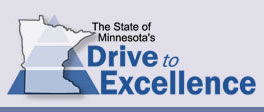 |
|
Six projects of the state's Drive to Excellence program are now underway. Four Mn/DOT managers will serve on the steering teams. |
Four Mn/DOT managers are among the dozens of state employees who will define the scope and timeline of the six initial projects in the state’s Drive to Excellence initiative, according to The Excellence Report, the initiative’s monthly newsletter.
Mn/DOT’s representatives are Donna Allan, Office of Transit, who will serve on the Grant Management steering team; Mike Barnes, Office of Information Technology (IT Governance); Jim Kinzie, Office of Finance (Sourcing), and Dick Post, Office of Maintenance (Real Property). Mn/DOT has no members on the other two steering teams, Construction and Building Codes Consolidation and Licensing.
As the steering teams move ahead, they will look for state employees who are experts in these six subject areas to help flesh out the details. Employees can get involved by going to the Drive to Excellence Web site or contacting Kathy Sibbel, Drive to Excellence program director, at excellence@state.mn.us or 651/284-3354.
The newsletter also reports the creation of a new state agency, the Office of Enterprise Technology, under the direction of a governor-appointed state chief information officer. Folded into this new agency are the Minnesota Office of Technology and InterTechnologies Group, both former divisions of the Department of Administration. The new agency started operations July 1.
For more information:
|
back

|
 |
Congress passes two-day extension on transportation funding bill |
 |
 |
The U.S. House and Senate passed, and President Bush has signed, a two-day extension of federal surface transportation programs. The extension, signed on July 19, includes two days’ worth of new contract authority and obligation authority, additional administrative funds for the Federal Highway Administration, and a two-day extension of the authority to expend from the Highway Trust Fund.
The extension expires at midnight, Thursday, July 21.
An FHWA spokesman said the very short extension is an indication that conferees feel they are close to an agreement on a long-term bill, and want to keep as much pressure as possible on the process.
For more information:
|
back

|
 |
Electronic Document Management System records one million hits |
 |
 |
More than 1 million actions (instances of documents saved, edited, opened or viewed) have been recorded in Mn/DOT’s Electronic Document Management System since the project began in July 2003. During that time, the EDMS staff designed, delivered and managed the “three-legged stool” of document management, records management and document workflow.
“EDMS provides a tool to support process improvement and builds a collection of reusable and sharable information assets that can be shared with internal and external partners,” said Nancy Melvin, EDMS manager.
Melvin said that EDMS excels at streamlining review processes. Traditionally, paper documents were passed sequentially from inbox to inbox or sent in the mail. Now in District 6, reviewers can access permit applications simultaneously and provide comments electronically with EDMS. Training on the permit review workflow process is now being conducted in Districts 1, 2, 3 and 8. The Office of Technical Support, Consultant Services Section, uses EDMS to review vendor applications for contract prequalification.
According to Dave Pehoski, EDMS workflow coordinator, “Preliminary results indicate that response time for review processes can be cut in half.”
Training for EDMS implementation in district design units is in progress or completed for Districts 1, 2, 4 and 6 and is being scheduled for remaining districts.
District 3’s Baxter and St. Cloud offices are pilot locations for a departmentwide GroupWise account management initiative. During this three-phase pilot, users will remove non business-related e-mail messages from their systems and move business messages to a shared drive, EDMS or paper file. A limit on the size of GroupWise accounts will also be implemented. Guidance will be provided to help employees determine which e-mails to save and where to save them. The statewide GroupWise account management initiative will begin in 2006.
“The objectives of this GroupWise initiative are to manage file server space, comply with records retention requirements and ensure access to business information,” said Michele Bliss, Mn/DOT records manager.
The EDMS Web site was recently redesigned and updated and can be accessed directly http://ihub.edms or from the iHUB home page http://ihub (Electronic Document Management System on the left side bar). The site provides training materials, online training, and a link to Web logon for viewing documents in EDMS. Standards and Best Practices for employee use of EDMS were approved by the EDMS Advisory Team on July 12 and are posted at http://ihub.edms/documents/standards.doc. Commissioner’s Staff approved a Mn/DOT Policy Position Statement and Policy Guideline for EDMS July 18 that will be posted soon.
As-Let Trunk Highway plans from 2000 forward will soon be scanned into EDMS. Trunk Highway plans from 1918 to 2000 are already available on the EDMS “Webtop.” From the Electronic Document Management System heading on the iHUB home page (left sidebar), click the pullout link to “Road and Bridge Plans."
Melvin will meet with all district management teams this summer to discuss EDMS progress.
“Communication, cooperation and peer support will enable us to provide for the future by capturing the knowledge and best practices of our workers,” she said. “Accessible and reliable information is critical to good decision-making and customer service. EDMS fosters the exchange of information between districts and the central office, within business areas, and with customers.”
By Pamela Newsome
|
back

|
 |
Innovative car-sharing program offers low-cost transportation |
 |
 |
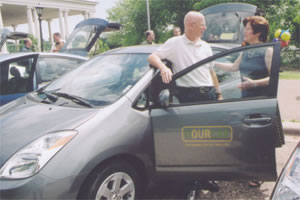 |
|
Ken Buckeye, Investment Management, and Mary Morse, director of St. Paul’s Neighborhood Energy Consortium, meet during the official start of the HourCar program. Photo by Craig Wilkins |
“Hey, neighbor, can I borrow the car?”
Neighbors sharing tools such as lawnmowers and snowblowers isn’t unusual; now residents of three Twin Cities neighborhoods can do something that is unusual —sharing a car.
The new HourCar program enables people in the Uptown and Loring Park neighborhoods in Minneapolis and the Lowertown area of St. Paul to use a new Toyota Prius at a fraction of the cost of owning one.
Mary Morse, director of St. Paul’s Neighborhood Energy Consortium, said it costs about $8,000 to own, operate and insure a new mid-sized car in the Twin Cities.
Program subscribers pay a monthly fee plus specified costs for the length of time they use the car and the number of miles driven. Subscribers, Morse said, pay a five-dollar monthly fee plus $6.95 per hour of use and 45 cents per mile.
The HourCar program is modeled on several successful car-sharing programs in other major cities. A part of funding for the program comes from a Guidestar ITS research project seeking information about travel patterns of elders, low-income people and recent immigrants in urban areas who do not own cars.
Ken Buckeye, value-pricing program manager, Office of Investment Management, said the program will help Mn/DOT determine how auto travel choices are made based on variable costs.
He said that because car owners have to pay certain fixed costs whether they use their cars or not, incentives to use public transit or other travel modes are greatly reduced.
“Data from the program will help us determine how willing drivers are to use options such as car-sharing, toll lanes, mileage-based user fees and other ‘pay as you drive’ alternatives to fixed-cost pricing,” he said. “The data we receive from the HourCar program will give us a more complete picture about how consumers react to price signals.”
By Craig Wilkins
|
back

|
 |
AirTAP newsletter now available electronically |
 |
 |
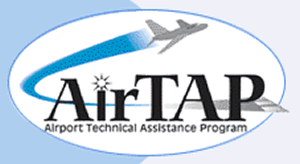 |
|
AirTAP's quarterly publication, Briefings, is now available online. It offers news and how-to information for staff operating, maintaining and administering Minnesota’s public-use airports. |
Minnesota airport professionals have another source of information now that the Airport Technical Assistance Program newsletter, Briefings, is available online.
Briefings is a quarterly publication that offers news and how-to information for staff operating, maintaining and administering Minnesota’s public-use airports.
AirTAP was developed through the joint efforts of Mn/DOT, the Minnesota Council of Airports, and the Center for Transportation Studies. Mn/DOT’s Office of Aeronautics provides the core funding for this program.
AirTAP is a statewide assistance program that provides education and information resources, training programs, technical assistance, access to experts and printed materials to public- and private-sector airport professionals. Subject areas range from airport lighting and snow and ice control to equipment purchasing and wildlife control.
Since AirTAP’s launch in 2000, Minnesota’s general aviation personnel across the state have had training and information on how to reduce costs, improve safety, quality and the overall efficiency of airport operations. The AirTAP program costs $200,000 annually.
AirTAP is modeled after the Local Technical Assistance Program at the Center for Transportation Studies.
“It has helped airport managers network, and that’s an important value that AirTAP has,” says Peter Buchen, Airport Development Section manager in the Office of Aeronautics. “Airport managers can communicate and find solutions to problems and issues that need to be resolved. That networking is one of AirTAP’s greatest resources.”
For more information:
By Lisa Yang
|
back

|
 |
Duluth/District 1’s Russ Kauzlaric dies at 62 |
 |
 |
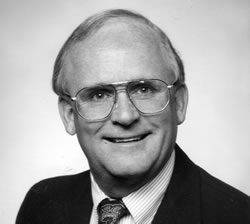 |
|
Russ Kauzlaric is shown here in 1994 when he was promoted to Assistant District Engineer. Photo by Grandmaison Photographic Studios of Duluth |
Russ Kauzlaric, assistant district engineer for program delivery with Duluth/District 1, died suddenly at his home in Duluth on July 5. He was 62.
Kauzlaric’s Mn/DOT career began in 1966 when he joined the department at District 1. He served in various engineering and managerial posts until he was appointed as an ADE in 1994.
Kauzlaric had planned to retire next year.
His survivors include his spouse, Kristianne Kauzlaric, a son, a daughter and one brother.
He was a native of Eagle River, Wis.
Kauzlaric held a bachelor’s degree in civil engineering from Michigan Technical University at Houghton and had done graduate work in civil engineering at the University of Minnesota.
Kauzlaric’s co-workers at District 1, as well as staff from other districts, the Wisconsin DOT, consultants, legislators, union officials and others expressed their sadness, affection and respect for him personally and professionally.
In a message to District Engineer Mike Robinson, Lynn Eaton, Bemidji/District 2 engineer, wrote: “Russ was such a good person; a calm voice of experience; always positive; such good humor; always self-effacing. His is a great loss for you, your management team and the department.”
Wrote Al Goodman, Lake County engineer: “Russ will certainly be missed by Lake County. A better, more professional engineer and manager would be hard to find. Lake County, too, grieves at the loss of such a fine man. We’re sorry for Russ’s family, both blood and working, and will miss him.”
District staff, including Robinson and John Bray, special assistant to the district engineer, compiled a memory book for Kauzlaric’s family that includes messages of condolence, photos and tape recordings of his voice mail greetings.
In a letter to Kauzlaric’s family, Robinson wrote: “Russ was in charge of getting all of our construction projects planned, designed and constructed. But most importantly, Russ was a true gentleman; he was always kind and compassionate to others in addition to being extremely knowledgeable about our engineering business.
“He always showed exemplary judgment and we all relied heavily on his counsel for the tough issues.
“My long-standing request of Russ was that he could retire the day after I did. I’m deeply saddened that this is no longer an option.
“His passing is a tremendous loss to Mn/DOT and to all of us personally.”
|
back

|
 |
|
 |



